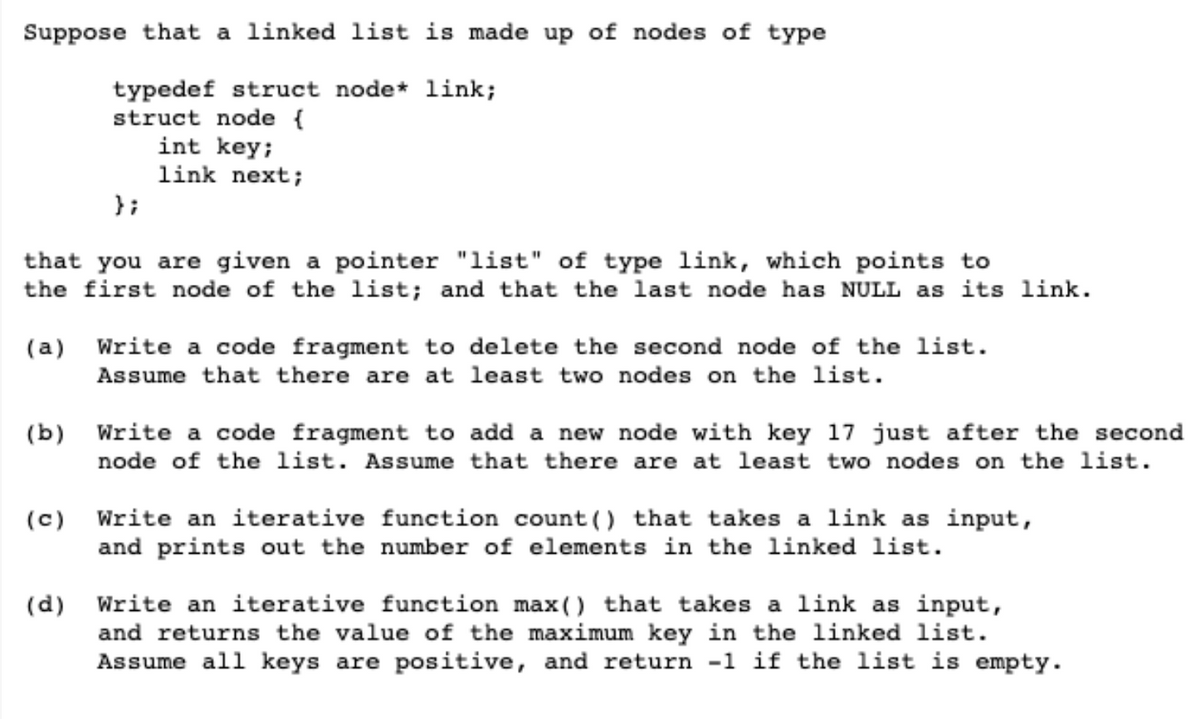Write a code fragment to delete the second node of the list. Assume that there are at least two nodes on the list. (a) (b) Write a code fragment to add a new node with key 17 just after the second node of the list. Assume that there are at least two nodes on the list. (c) Write an iterative function count () that takes a link as input, and prints out the number of elements in the linked list. (d) Write an iterative function max() that takes a link as input, and returns the value of the maximum key in the linked list. Assume all keys are positive, and return -1 if the list is empty.
Write a code fragment to delete the second node of the list. Assume that there are at least two nodes on the list. (a) (b) Write a code fragment to add a new node with key 17 just after the second node of the list. Assume that there are at least two nodes on the list. (c) Write an iterative function count () that takes a link as input, and prints out the number of elements in the linked list. (d) Write an iterative function max() that takes a link as input, and returns the value of the maximum key in the linked list. Assume all keys are positive, and return -1 if the list is empty.
Computer Networking: A Top-Down Approach (7th Edition)
7th Edition
ISBN:9780133594140
Author:James Kurose, Keith Ross
Publisher:James Kurose, Keith Ross
Chapter1: Computer Networks And The Internet
Section: Chapter Questions
Problem R1RQ: What is the difference between a host and an end system? List several different types of end...
Related questions
Question
Please solve in any language of your choosing.

Transcribed Image Text:Suppose that a linked list is made up of nodes of type
typedef struct node* link;
struct node {
int key;
link next;
};
that you are given a pointer "list" of type link, which points to
the first node of the list; and that the last node has NULL as its link.
(a) Write a code fragment to delete the second node of the list.
Assume that there are at least two nodes on the list.
(b) Write a code fragment to add a new node with key 17 just after the second
node of the list. Assume that there are at least two nodes on the list.
(c) Write an iterative function count() that takes a link as input,
and prints out the number of elements in the linked list.
(d) Write an iterative function max() that takes a link as input,
and returns the value of the maximum key in the linked 1ist.
Assume all keys are positive, and return -1 if the list is empty.
Expert Solution
This question has been solved!
Explore an expertly crafted, step-by-step solution for a thorough understanding of key concepts.
This is a popular solution!
Trending now
This is a popular solution!
Step by step
Solved in 2 steps with 1 images

Recommended textbooks for you

Computer Networking: A Top-Down Approach (7th Edi…
Computer Engineering
ISBN:
9780133594140
Author:
James Kurose, Keith Ross
Publisher:
PEARSON

Computer Organization and Design MIPS Edition, Fi…
Computer Engineering
ISBN:
9780124077263
Author:
David A. Patterson, John L. Hennessy
Publisher:
Elsevier Science

Network+ Guide to Networks (MindTap Course List)
Computer Engineering
ISBN:
9781337569330
Author:
Jill West, Tamara Dean, Jean Andrews
Publisher:
Cengage Learning

Computer Networking: A Top-Down Approach (7th Edi…
Computer Engineering
ISBN:
9780133594140
Author:
James Kurose, Keith Ross
Publisher:
PEARSON

Computer Organization and Design MIPS Edition, Fi…
Computer Engineering
ISBN:
9780124077263
Author:
David A. Patterson, John L. Hennessy
Publisher:
Elsevier Science

Network+ Guide to Networks (MindTap Course List)
Computer Engineering
ISBN:
9781337569330
Author:
Jill West, Tamara Dean, Jean Andrews
Publisher:
Cengage Learning

Concepts of Database Management
Computer Engineering
ISBN:
9781337093422
Author:
Joy L. Starks, Philip J. Pratt, Mary Z. Last
Publisher:
Cengage Learning

Prelude to Programming
Computer Engineering
ISBN:
9780133750423
Author:
VENIT, Stewart
Publisher:
Pearson Education

Sc Business Data Communications and Networking, T…
Computer Engineering
ISBN:
9781119368830
Author:
FITZGERALD
Publisher:
WILEY